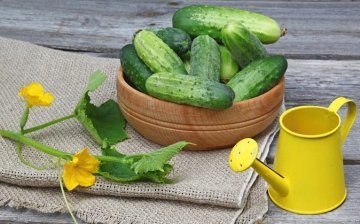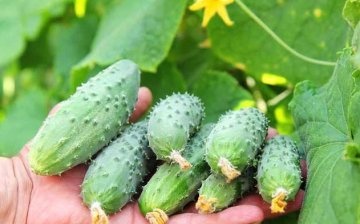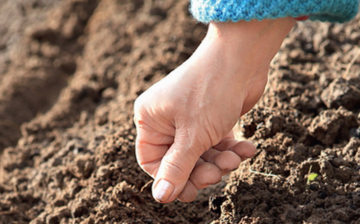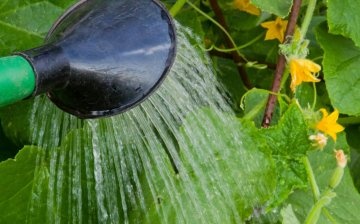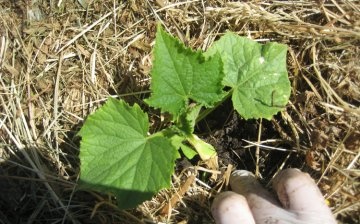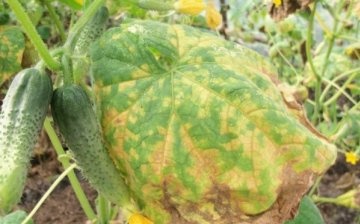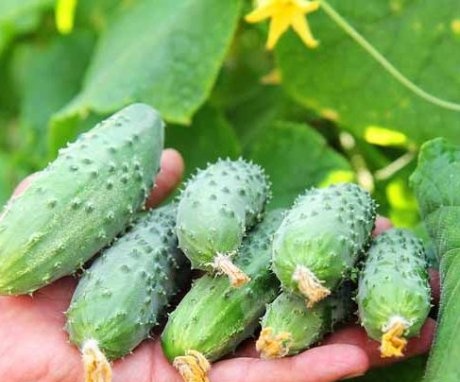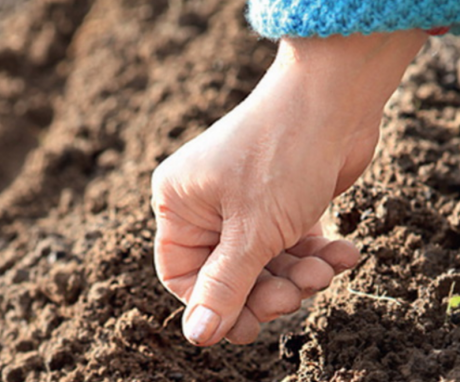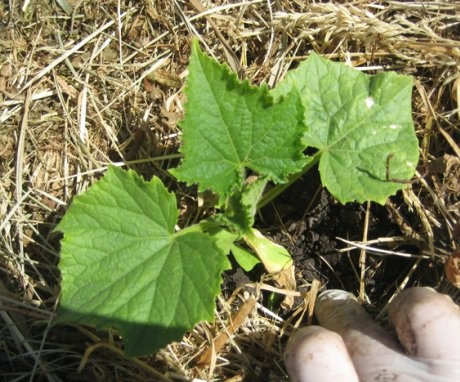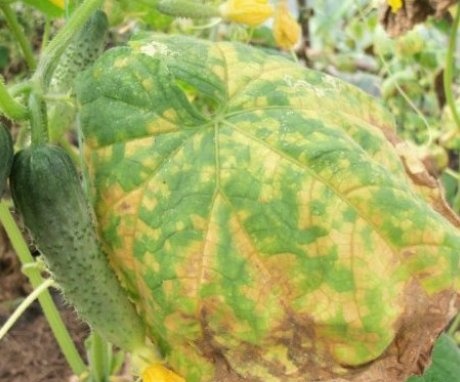How to grow a good harvest of cucumbers: tips, secrets and rules
For a good harvest cucumbers, you need to carefully consider several important points. Among them: the right choice of varieties of cucumbers, competent planting, proper care and watering. Experienced gardeners know exactly how to handle the plant in order to ultimately reap the maximum yield.
Content:
- The best varieties of cucumbers for open ground
- Seed and soil preparation
- Landing: timing and rules
- Watering and feeding
- Loosening the soil, pinching and mulching
- Diseases and pests - control and prevention
The best varieties of cucumbers for open ground
Cucumber has been cultivated by different peoples and in a wide variety of conditions for a long time. Throughout its history, the plant has transformed into many species, each of which is optimized for specific conditions. Sowing cucumbers in open ground must have special characteristics that differ from analogues that are grown in a greenhouse.
The optimal choice for open ground will be specially bred varieties and hybrids that are resistant to temperature jumps and changes in the level of air humidity. Also, such varieties have resistance to numerous diseases that plague plants in the open field.
Among the popular varieties of plants are
- Phoenix 640
- Phoenix Plus
- Competitor
They are in demand by gardeners due to their resistance to various diseases.
Seed and soil preparation
If you just take and sow cucumber seeds in the first soil you come across, you will also get a crop. Only it will be extremely small and most likely to be damaged by insects and pests... But if you complete the necessary complex of preparatory work. The result will be much better.
Choose your sowing site carefully. The area designated for sowing with cucumbers must be protected from the wind, and also have sufficient lighting and heat flow. The best solution would be to place the beds from north to south.
To feed and form the necessary characteristics of the soil, sawdust, peat, and straw should also be introduced.
The cucumber plant requires a fairly well matched soil. Soil requirements allow you to create optimal conditions for growing vegetables. For a cucumber, thoroughly loosened soil with a neutral reaction is necessary. For the gardener, you should first dig up the soil in the fall to a depth of about 30 centimeters, where you additionally add 1-2 buckets of manure. In some cases, you can add 2 tablespoons of lime. After the soil dries up in the spring, you need to re-dig up the soil by about 10 centimeters, and if the soil is clayey, then by 20 centimeters.
Landing: timing and rules
It is widely believed among many gardeners that cucumbers should be sown in seedlings. Of course, this method has its advantages, but it is far from the only one. Depending on climatic conditions, it is allowed to sow cucumber seeds directly on the beds.
It is recommended to plant the beds in several passes to prevent freezing due to unexpected frosts. Also, this approach to sowing helps to increase the yield.
Sowing usually begins in mid-May and continues until mid-June.
If you sow a cucumber later, then a long day of light does not favorably affect the development of the plant in the first period of ripening. The varieties differ in terms of ripening, which makes it possible to select crops in such a way that the cucumbers ripen gradually, providing a long harvest time and an increase in the fruiting period.
Watering and feeding
Cucumber is one of the crops that contains a large amount of water. Therefore, great demands are made on the irrigation regime. If there is not enough moisture, then the development of ovaries is inhibited, and the yield is significantly reduced. But it is also unacceptable to overdo it with watering, because the plant can lose root hairs and gradually die.
For watering in greenhouses, different watering methods are used. Including use hoses, sprinkler irrigation and drip irrigation... They are alternated as necessary to achieve optimal results. In the morning, cucumbers are watered with warm water, bringing it into the root bush. After the beginning of flowering, cucumbers are watered 2 times a week. As soon as the bush begins to bear fruit, they switch to watering 2 times a day, providing the plants with a large amount of moisture.
The irrigation regime is adjusted taking into account the characteristics of the soil.
The mechanical composition determines the nature of plant growth. The best option would be to choose neutral soils, abundantly saturated with humus. It is not allowed to sow the plant on heavy soils that have a low level of groundwater occurrence.
For germination and formation of cucumber seedlings, a special nutrient mixture is used, which is abundantly nourished with various fertilizers:
- In order for the seedlings to develop evenly and form a high-quality plant, it is necessary to feed the bush every 5 days complex fertilizers.
- Immediately before sowing, about 1 bucket of humus per square meter is introduced into the soil.
- Every week after planting, you need to feed the cucumbers until the formation of ovaries. This process is combined with abundant watering.
- As soon as the bush begins to actively bear fruit, the feeding regime is constantly adjusted. The dosage of the applied complex fertilizers is changed, which are added to the water at the rate of 50 grams per 10 liters of water.
- If cloudy weather is observed, then you need to add about 1 gram of fertilizer per 1 liter of water for the harmonious development of the plant and obtaining the required amount of fruits.
Loosening the soil, pinching and mulching
After the cucumber bush has formed its shoots, the soil should be periodically loosened. This is done to ensure sufficient aeration. root system and uniform development of the underground part of the plant.
An important component for the protection of the young basal process is mulching, which is the formation of a protective cushion to prevent root freezing and negative environmental impact.
For the care of cucumbers, an important component is the formation of a plant through pruning and adjusting the shape of the bush:
- Timely trimming stimulates the development of lateral shoots, on which the formation of female flowers occurs.
- The very process of forming a bush is performed by pinching the central, most powerful stem. After that, the development of other directions of growth takes place.
In addition to popular ways to stimulate the development of cucumbers, gardeners also often use methods such as changing watering. This technology, which consists in temporarily interrupting the regular application of water, leads to the stimulation of the formation of female appendages.This is explained as follows: the bush, due to a lack of moisture, begins to rebuild its work in order to form as many new fruits as possible. And this happens because the plant is afraid to die. Also, for the development of cucumbers, they are often planted in mixed plantings, combining together different varieties and hybrids of a given culture.
Sometimes special banding of the stems is carried out.
- A shallow incision is made around the stem.
- The site of the incision is located under the first pair of leaves.
This stops the outflow of nutrients to the roots and the formation of new ties. Foliar feeding of cucumbers is carried out with the help of urea. It is brought in approximately at the rate of 20 grams per 10 liters of water. It is best to do this job in cloudy weather.
After removing the first formed ovary, an increase in yield is also observed. Some experienced gardeners suggest attracting bees and honey insects to the bush in order to improve pollination. For this, sugar syrup is poured onto the leaves and flowers.
Diseases and pests - control and prevention
Often, when growing cucumbers in greenhouses and greenhouses, a sharp deterioration in the state of foliage occurs, which becomes covered with white spots and soon dries out completely. This is a sure sign of the development of a spider mite. Sometimes this pest also affects plants in the open air. The insect has a miniature size that is less than 1 millimeter.
Cucumbers can also be attacked by melon aphids. Like a tick, it leads to the drying out of foliage and its complete destruction. To prevent such attacks of insects, it is imperative to treat all the bushes with an abundant amount of special means to prevent the development of insects. It is also important to provide the required amount of nutrients. Regularly arriving at the roots - this is how the plant strengthens and it can independently resist pests.
More information can be found in the video:



